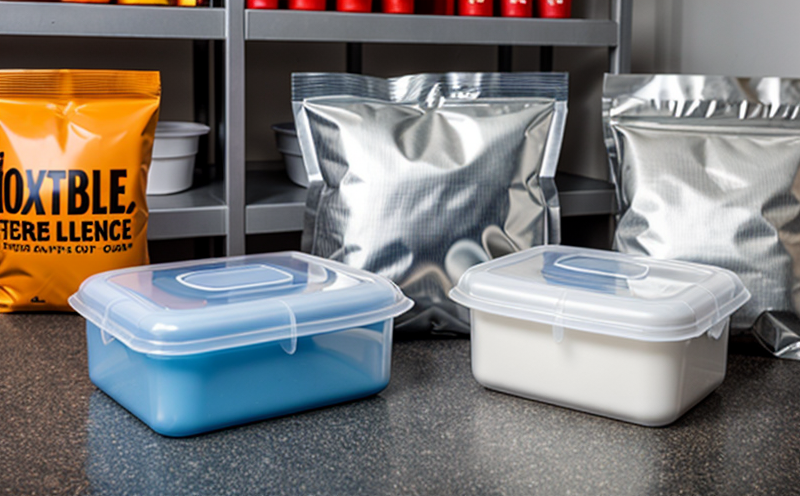ISO 15105-3 Permeability of Packaging Films
The ISO 15105 series is a comprehensive set of standards for the testing and evaluation of packaging films. The third part, ISO 15105-3, specifically addresses the determination of gas permeability through packaging materials used in flexible packaging.
This test method is critical for ensuring that packaging meets the required performance criteria for protecting products during storage and transportation. It helps to minimize product spoilage by preventing the ingress of unwanted gases such as oxygen, carbon dioxide, or moisture vapor. This is particularly important for food and pharmaceutical industries where maintaining the freshness and integrity of goods is paramount.
The standard specifies a dynamic method using a permeability cell with a known volume. The test involves placing a sample between two plates of the permeation chamber, creating an atmosphere on both sides that is different from one another in terms of gas concentration or pressure. As the gases move across the film, they cause changes in the pressure within the chamber, which can be measured and used to calculate the permeability coefficient.
For accurate results, it's essential to follow all procedural steps precisely, including specimen preparation, conditioning, and calibration of equipment. Specimens should be cut from the packaging material, conditioned under specified temperature and humidity conditions before testing begins. The test chamber must also be calibrated accurately to ensure reliable measurements.
The permeability coefficient is expressed as cm3/m2/day at a specific temperature (typically 50°C) and relative humidity (95% RH). This value indicates how much gas can pass through one square meter of the packaging film in one day under these defined conditions.
- Gas Permeability: Oxygen, carbon dioxide, nitrogen, helium
- Materials Tested: Polyethylene (PE), polyvinyl chloride (PVC), polyester (PET), nylon (NYLON)
- Industry Applications: Food and beverage packaging, pharmaceuticals, cosmetics
Quality and Reliability Assurance
The ISO 15105-3 test is integral to the quality assurance process in several ways. It ensures that the packaging film maintains its integrity throughout the supply chain, protecting products from damage or contamination. By regularly testing samples according to this standard, manufacturers can identify any issues early on and make necessary adjustments before they impact customer satisfaction.
Compliance with these standards is also crucial for maintaining a good reputation among consumers who are increasingly concerned about food safety and environmental sustainability. Meeting regulatory requirements helps businesses avoid costly recalls and potential legal actions while enhancing brand loyalty.
In R&D environments, ISO 15105-3 serves as a valuable tool for innovation. Engineers can use the results from these tests to develop new materials or improve existing ones, leading to more efficient production processes and better-performing products.
For procurement teams looking to source reliable suppliers, this test provides assurance that the packaging meets the necessary standards. Knowing which vendors comply with ISO 15105-3 allows companies to focus their efforts on those who can provide consistent quality across all batches of goods received.
Customer Impact and Satisfaction
The impact of accurate gas permeability testing extends far beyond just the manufacturing process; it directly affects customer satisfaction. When products arrive at their destination in pristine condition, customers are more likely to be pleased with their purchase experience.
For example, if a food item has been properly protected from oxygen and moisture during transport, it will retain its freshness longer, leading to higher sales for retailers and increased profits for producers. Similarly, pharmaceutical companies can ensure that their products remain stable throughout distribution channels, reducing the risk of recalls due to spoilage.
In addition to enhancing product quality, ISO 15105-3 testing contributes significantly to overall customer satisfaction by improving logistics efficiency. Efficient packaging means reduced handling costs and shorter delivery times, all contributing positively towards an enhanced customer experience.
Moreover, the ability to predict how long a package will keep its contents safe allows businesses to plan better inventory management strategies. This foresight helps prevent overstocking or understocking scenarios that could lead to waste or lost sales opportunities respectively.
Environmental and Sustainability Contributions
- Eco-Friendly Materials: By optimizing packaging films for gas permeability, manufacturers can choose eco-friendly materials that offer better protection without compromising sustainability goals.
- Reduced Waste: Properly sealed packages reduce the likelihood of leaks, meaning less waste generated from spoiled products during transit or storage.
- Energy Efficiency: Optimizing packaging to minimize permeability can lead to more efficient energy use in refrigeration systems, as there is reduced need for continuous cooling.





